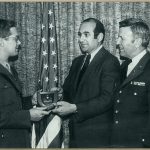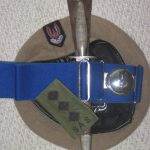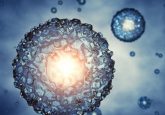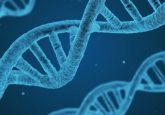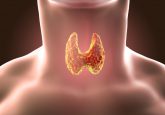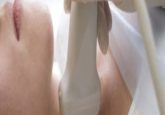An interview with V. Craig Jordan: breast cancer, SERMs, tamoxifen
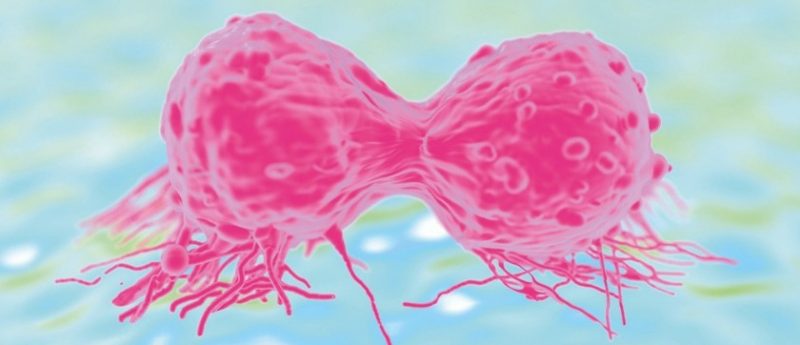
In this interview, Jenny Straiton (Future Science Group) speaks with internationally renowned breast cancer scientist, V. Craig Jordan (UT MD Anderson Cancer Center, Houston, TX, USA). Read the second part of the interview here, in which V. Craig shares his top tips for students looking to pursue a career in this field.
1. How does it feel to have won the Reynold Spector Award and gained such recognition for your work?
To me this is phenomenal. I’ve focused all my career on being a professional pharmacologist, I wanted to do something that wasn’t popular; I wanted to develop drugs for cancer. I am a fellow of the British Pharmacological Society (UK) and have maintained my membership there since about 1976. I am a member of the American Society for Pharmacological and Experimental Therapeutics (USA) as well. Both societies have been very generous to me over the years with recognition with awards and prizes on both sides of the Atlantic and now, towards the end of my career, being awarded this is a great honor.
2. What were your goals when you first started out as a scientist? Did you ever imagine getting here?
What I wanted to do was to use chemistry to develop drugs to treat cancer; no idea why.
I wasn’t a particularly good student, I wanted to teach and I wanted to study chemistry, but I was not necessarily academically interested in what they wanted to teach me. I was put in detention a lot but I learnt organic chemistry synthesis there and used it as a self-propagating education process.
At my grammar school the careers masters gave me access to laboratories, they allowed me to do chemistry in my spare time, in the lunch breaks etc. This is something that would never be allowed now, but I was there alone or teaching the other pupils.
My mother had allowed me to convert my bedroom into a chemistry laboratory at the age of 14 and I would do experiments. I’d be throwing burning stuff out of the window and the curtains would be on fire, but her view was that, at least we know where he is, he could be doing this somewhere else. I developed a sort of obsession with chemistry, finding old chemistry books and learning chemistry; that was what I wanted to do that’s what I ended up doing.
3. What would you say has been your greatest achievement so far?
Others say that taking ICI 46474 (tamoxifen), the failed contraceptive, to become a breast cancer drug would be my greatest contribution though it’s not; the pharmaceutical industry was doing it anyway.
I would say my main contribution was in determining three different things in breast cancer treatment; target the estrogen receptor, use this for prevention and maintain long-term tamoxifen therapy for results to occur.
As a pharmacologist I’m interested in mechanisms and how to explain the strange results we might get in the lab. One of these strange results came when I was at the University of Wisconsin (WI, USA), showing that tamoxifen would switch on and switch off sites around a woman’s body. In the experimental mouse model, it would cause the uterus grow, which was odd, but breast cancer would not. We also found that tamoxifen could help maintain bone density and would lower circulating cholesterol. I started a whole drug group, now called selective estrogen receptor modulators (SERMs), which were able to target one disease though also act as multifunctional preventative medicines.
We had raloxifene, a failed breast cancer drug that the industry didn’t want as it couldn’t compete with tamoxifen, and could target it to the treatment of osteoporosis; though not its primary function, it can prevent breast cancer at the same time. We now have a compound known as lasofoxifene which decreases stroke in post-menopausal women, stops endometrial cancer, gives 70% decrease in breast cancer, stops osteoporotic fractures.
No other medicine group suddenly says, ok we’re going to treat you for the common cold and, oh by the way, at the same time you’re going to be inoculated against polio and your bones will do better. The cross talk that we have with the SERMs provides an enormous advantage that is unique. In the future we might find other nuclear receptors to target, not just with the estrogen receptor as we have with women’s diseases, which give opportunities to treat diseases that we never thought of.
4. Where do you envision the pharmacologic treatment of breast cancer going in the next 5-10 years?
I see a problem in the way that the pharmaceutical industry has gone in that it takes a good idea and runs with it, focusing on that specific idea with little variation. Now industry has lost the patent for tamoxifen and aromatase inhibitors, both acknowledged as good ideas, industry has exploited what they have got, Faslodex® (fulvestrant), and take what is currently an injectable but now develop an oral version.
Faslodex is a selective estrogen receptor degrader (SERD) and what I don’t like is the idea of condemning these women to an estrogen free life. Estrogen is really important for physiology and life; loss of it can lead to osteoporosis, coronary heart disease, possibly Alzheimer’s. Now they want somebody to go onto a drug that, though it will help their cancer, will increase all of these associated diseases at the same time; improved health often comes second when it’s a life-threatening disease.
More women die of coronary heart disease or osteoporosis in their eighties than breast cancer so I think the bottom line is that we need to develop a much more effective SERM that not only you can use to treat breast cancer, which we know how to do with SERMs, but we need to be able to simultaneously give protection from coronary heart disease, strokes and the ability to have strong bone, none of which happens with a pure anti-estrogen. I will keep banging my drum about this but it’s not about me, it’s about patents and money.
5. In your opinion, what has been the greatest change in the field of clinical pharmacology over the course of your career?
I want to make a quote here from George Patton, the famous American general who really didn’t pay much attention to anyone else; ‘If everybody is thinking alike then somebody isn’t thinking’. I think that’s very true, you get group mesmerism were everybody feels like they have to agree but really, it’s the people thinking outside of the box that are actually the winners.
At the beginning of my career there was an obsession with the idea that that combination chemotherapies were going to cure all cancers; they’d cured leukemia in children, they were about to cure Hodgkin’s disease and huge efforts were done with bone transplants.
They were trying to get chemotherapy to cure all stages of breast cancer but it was not possible, it absolutely did not work. The agents were poor and the combinations were too toxic for patients; you’d have to kill the patient to kill the cancer.
This idea would have smothered tamoxifen at birth if there hadn’t been people willing to fight for it and prove the clinical community incorrect. It felt like we were trying to swim upstream as we were saying no, target the estrogen receptor and give tamoxifen forever and people will stay alive. The clinical trials of the time were only giving 1 year of tamoxifen, this wasn’t going to work either but long-term tamoxifen is; longer is better and now we have clinical trials data able to prove that.
Thirty years ago, breast cancer survival was very low. Now, 40% of people with breast cancer survive. The huge change is that chemotherapy has now taken a back seat and targeted therapy, of which tamoxifen became the first, is taking the driving seat.
6. What legislation would you change to improve science in your field?
Well that’s a very interesting thing, in my career I’ve paid little attention to legislation.
When I first came to America there was a very liberal point of view about funding. They wanted to fund bright young scientists with ideas so when you came up with a good idea, the NIH advisory committee would help you to get a fundable grant; they would review it, send it back then you would go back again, and you would eventually get something.
That doesn’t really happen anymore because there’s no money, and there’s no money because the government is being starved of money in general. The major driver of research is that coming from America, though in America there is this philosophy that if you have a good idea, start a company and make America great; take your idea and do the entrepreneurial thing because this is what America is all about, forget all this spoon-feeding sort of stuff from the government. The government has done some remarkable things, regrettably it is rather inefficient I’ll give you that and it’s not going to set the world on fire, but it did at one time in the 60’s and 70’s.
Now we have an impasse where the pharmaceutical industry is being asked to do drug discovery which is something they don’t really do, they do drug development, clinical trials and safety. The discovery is really found in the university and at the small biotech companies that’ll never really survive anyway. So, what would I do to change the government? Not possible.
7. Could you tell me about the multiple prizes and lectures in your name at Leeds and Oxford University (both UK)?
Something I am really passionate about is investing in the next generation and I think it is the most important thing you can do. In my first year at University of Leeds, I won an Akroyd scholarship for having the highest score ever recorded in the organic chemistry third year course. It really helped me having a prize, something written down that says you are a top student, it really gives you a boost in self-confidence. This is something that I really wanted to promote and so there has been the Jordan prize for medicinal chemistry for the last 20 years. There is now also a prize for the best PhD student in biophysics and, because I was an officer cadet at Leeds, I also have the starter prize for the best officer cadet every year.
There is now a Jordan lecture in translational medicine at Oxford University (UK) at the Weatherall Institute where they get the best people they can from around the world to come and talk to the PhD students and post docs and tell their story, what it is that really made their career. I want to inspire these young people and if I can get one or two people to move forward and cure cancer or win the Nobel prize, great!
8. So, you’re a reserve officer in the intelligence corps and the SAS with a NATO top secret clearance and have been trained as a narcotics agent – how did that happen?
Image A: Captain Jordan in the Intelligence Corp. at an awards ceremony recognizing his voluntary service in the British Army during his two years in America.*
This is something that I’ve not spoken about at all but now we’re well past those days and certain things can be published.
I am passionate about repaying my debt for the free education that I had in Britain. I had a grant that paid for my fees at Leeds which allowed me to progress through the department of pharmacology up to PhD level where I got a grant from the Medical Research Council.
I came from a family where my grandfather had been an army officer in both world wars and who absolutely believed in doing the right thing and, as far as he was concerned, service was the right thing. As soon as I got to Leeds, the first thing I did was to sign on to the army’s officers’ training corps. In my commissioning interview for the British Army, when they asked me why I wanted to be an officer, I said, ‘if you give me the opportunity to be an officer, what I want you to do is to send me off on every nuclear chemical and biological warfare course you have; I will train as best as I can to be able to help whomever I can’. During this training I got talent spotted by the Deputy Chief Scientist for the army who said that, if I were to pass Top Security clearance, they were going to immediately make me captain, which was boosting me up very quickly, and I was to be the nuclear chemical and biological warfare expert in Germany, dealing with NATO should the Russians come over the border.
Image B. Captain Jordan presenting a lecture on nuclear, chemical and biological warfare at Region I headquarters.
I was leading these parallel lives, disappearing all the time to go off and do army things in Germany all whilst doing my PhD in Leeds. When I went to America to do my post doc, I asked the Deputy Chief Scientist to attach me to the American army. Another things I’d been doing in the British army was talking to regular army units about drug abuse. When I went over to America it was during the Vietnam War era when the Army had a big drug problem, so I went to the Bureau of Narcotics and Dangerous Drugs to see if there was anything I could do to help. Despite not being a law enforcement officer, my connections with the deputy chief scientist helped me to get onto the narcotics officer’s course for the Bureau of Narcotics and Dangerous Drugs and I remain the only civilian to have done so.
Image C. Captain Jordan was selected for the SAS in 1975, and this is his parachute smock and combat uniform for European service in NATO.
During my time with the American army I was in a unit stationed in a bunker, covering the whole of the eastern seaboard. My job as the nuclear chemical and biological warfare officer meant that, in time of war, I would be responsible for talking to Air Force One to tell whoever the President of the United States was at the time whether towns on the eastern seaboard existed. I was in a very privileged position, giving these updates as they were flying over America somewhere safe.
Image D. Emblems specific to the SAS, Captain’s Officer Rank Badges, Jordan’s barret and the iconic SAS knife.
Returning to Britain I went back to being a lecturer in pharmacology at Leeds. After about a year, there was a knock on the door and a man standing there says, ‘I know who you are, you don’t know who I am, I need help with my Regiment and you’re the one to do it’. I had been now picked for selection to the SAS. If the Russians came over the border, their job was to identify Russian targets; I would talk to the Americans regarding how to dispose of said targets. I spent the rest of my career as a regular army reserve officer in the SAS and I was very proud to do so.
I’m also an outstanding shot.
Profile: Virgil Craig Jordan, OBE, PhD, DSc, FMedSci is a scientist specializing in drugs for breast cancer treatment and prevention. He is Professor of Breast Medical Oncology, and Professor of Molecular and Cellular Oncology at the University of Texas MD Anderson Cancer Center.
Related content
